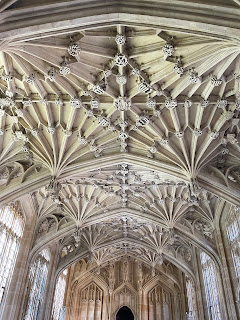 |
| Vaulted ceiling at the Bodleian |
The Bodleian Library is the main research library for all the individual colleges that form the University of Oxford (see website). Established in 1602, it is the second-largest library in Britain after the British Library and holds over 12 million items. It is open every day of the week but, except for tours, is only available to those affiliated with Oxford or those who have obtained permission to use it for research. The collection is non-circulating. The library complex includes four historic buildings and a more recent building called the Weston Library that contains offices and 11 floors of stacks (the Westons are apparently generous Canadians).
 |
| The Radcliffe Camera is now part of the Bodleian Library |
 |
| William Cecil |
 |
| Inside the Library |
 |
| From the Library |
 |
| The Great Hall |
Books bought: 1, but I returned it on Friday




Busy weekend here so just catching up with your posts. Sounds like there're a few snooty staff members in the Oxford colleges and libraries. It's 'years' since we were at the Bodleian, our youngest was 16 (she's now 45) and had just done her GCSEs. Her older sister didn't want to come away with us so the three of us hired a house in Chipping Norton in the Cotswolds and went to Oxford, Blenheim Palace and enjoyed the Cotswold villages.
ReplyDeleteWhat a shame you came across snooty types and gatekeepers.
ReplyDeleteWhen I was a student myself, my then-boyfriend's close friendship group had all got in to Oxford. We used to go and stay with one of them, at Christ Church - he had a room as big as our whole house, with a cunning arrangement to hide a washbasin and a piano in the room (he's now Something at Sotheby's!). It was terrifying to go for a meal in a borrowed short gown and have to admit one was at Birmingham!